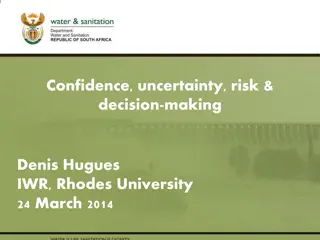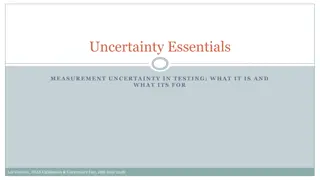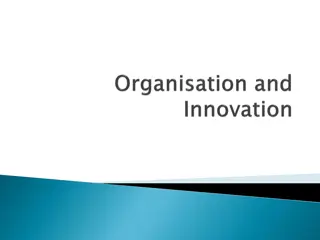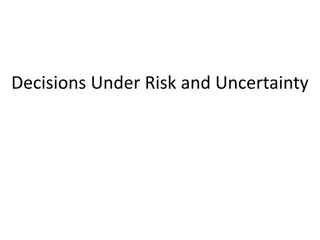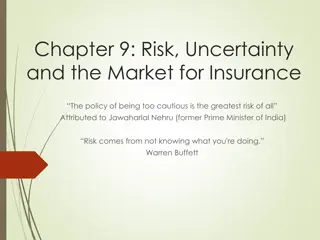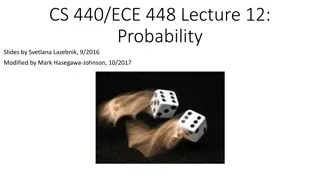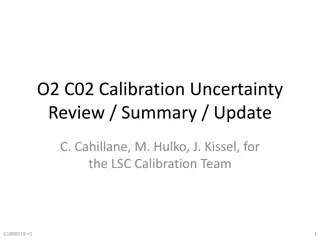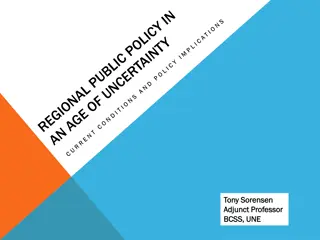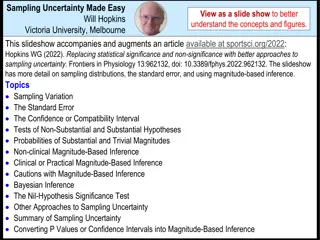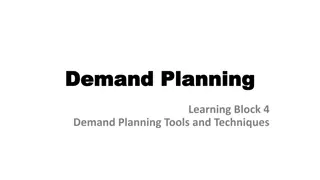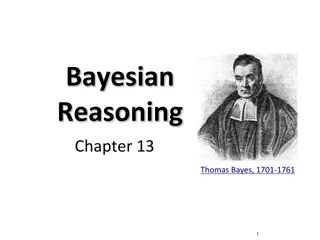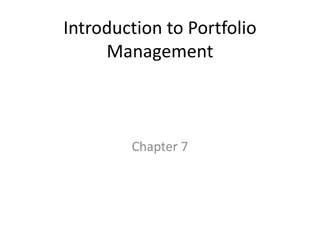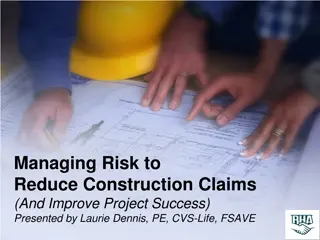Ergodicity: Managing Risk under Uncertainty
Concept of ergodicity and how it relates to risk management. Explore how lawyers can help avoid ruin, why volatility can be a form of stability, and the importance of being antifragile. Discover key examples and practical applications in various fields.
Download Presentation

Please find below an Image/Link to download the presentation.
The content on the website is provided AS IS for your information and personal use only. It may not be sold, licensed, or shared on other websites without obtaining consent from the author. Download presentation by click this link. If you encounter any issues during the download, it is possible that the publisher has removed the file from their server.
E N D
Presentation Transcript
Ergodicity: Managing Risk under Uncertainty Patrick Wilson Compliance Officer The Co-operative Bank
Key takeaways - The concept of ergodicity - How lawyers can help avoid ruin - Volatility is stability - We want to be antifragile - Small is beautiful
Technical and useful definitions Technical: when the time probabilities and ensemble probabilities converge, something is ergodic. In all other cases, it is non-ergodic. Plain English: if you can expect the average result in a given situation, something is ergodic. If you can t, or if there is a risk of ruin, it is non-ergodic and you should either avoid the risk or insure yourself against it.
The extreme examples Ergodic: flipping a coin Whether you flip the coin 100 times yourself or 100 people flip the coin once, the average result will remain the same (approximately 50% heads and 50% tails). Non-ergodic: Russian roulette If 100 people play, 83.333% survive. If you play 100 times, you are dead (the actual number is much less than 100 times).
Everyday examples Height is ergodic. To survive, adults can only be in a specific, defined range (up to 272 cm). If the average height of 100 people is 175 cm, then even having Robert Wadlow in the room wouldn t move the average much. Wealth is non-ergodic. If you have 100 people in a room and the average wealth is $2.5 billion, what is the most likely outcome? Elon Musk or Bernard Arnault are in the room with 99 people who have no money comparatively. Italy during the Covid-19 pandemic. On average, 10% of Italian hospital beds had Covid-19 patients. In Lombardy, there was not enough room in hospitals to care for the ill. What works on average can fail locally.
The Long-Term Capital Management story; or how to almost crash the world economy Key players for our purposes: John Merriwether Founder, former head of bond trading at Salomon Brothers Myron Scholes Partner and co-recipient of 1997 Sveriges Riksbank Prize in Economic Sciences in Memory of Alfred Nobel Robert Merton Partner and co-recipient of 1997 Sveriges Riksbank Prize in Economic Sciences in Memory of Alfred Nobel Jim Rickards General Counsel
Long-Term Capital Management Overview Started with $1 billion in 1994 Grew to $4.6 billion in assets in 1998 Controlled >$1 trillion in derivative contracts, for which they had to pay premia at set times Returned over 40% pa between 1994 and 1997 (the year Scholes and Merton won the Bank of Sweden Prize in memory of Nobel) Went bust in 1998
What went wrong? Think about the stock market crash of 1987 and the odds of it happening Statisticians called it a 20-sigma event; an 8-sigma event will occur once in the time period since the Big Bang LTCM calculated the likelihood of it going bust as even longer odds than that So LTCM leveraged itself to the hilt; their leverage ratio was as high as 250:1 LTCM did not protect itself and neither insured its positions nor took opposite positions to protect itself from loss Crucially, neither did their counter-parties.
Moral(s) of the story First, all models are wrong, but some are useful. Second, the markets can remain irrational for longer than you can remain solvent. Third, if you employ an excellent lawyer that understand tail risk and can prevent you from ruin or get counter-parties to accept the risk, you are sitting on a gold mine. Fourth, if you owe the bank $1 million, the bank owns you. If you owe the bank $1 trillion, you own the bank.
The bet I wish Id asked you to take before explaining the concept
How to go broke on a favourable bet We are going to flip a coin 100 times. You start with $100. Every time the coin lands on heads, your wealth increases by 50%. Every time the coin lands on tails, your wealth decreases by 40%. The average return over 10,000 trails is $16,000. Would you take this bet?
Stability v Volatility What does stability look like to you? What does volatility look like to you? Examples: Emotional stability: is it someone who has lots of little swings or someone who has rare, massive blow ups? Economic stability: is it gaining slowly over time, with lots of small movement or is it big gains for a time followed by a major crash?
How to use the concept of ergodicity as a lawyer Anticipating and managing regulatory risk What, if we don t comply, could result in us losing our license? What could result in losses that could bankrupt us? What could result in our board or executive going to jail? Contract negotiations Where are we exposed to unreasonable liability? Where could we run into compounding issues for which we require indemnification? What can we do to get out of bad contracts that expose us to too much risk? How can we insure ourselves against heavy losses? What protections do we have if the counter-party goes bust? Litigation Management If we were to be sued for a large amount, what are the most likely reasons? What actions can we take now to eliminate the risk or reduce our exposure to it?
Ergodicity and climate change Climate change and its effect are non-ergodic. Recent reports state the sea ice levels are a five sigma or six sigma event, or something that happens every 7.5 million to 500 million years. Since climate change is non-ergodic, we cannot use ergodic tools to measure it. Risk of ruin No given place can expect the average result; it is non-ergodic across areas. In other words, while it will have effect a on the global climate, each micro-region could have different effects which cannot be accurately modelled. More action is needed, and more diverse and smaller action is needed (focus on what you can change locally, share ideas, adopt new ideas that work for your area).
Ways to mitigate or avoid non- ergodic risks Break risks into smaller pieces, each of which is survivable (prefer many small projects to single- point-of-failure big projects) Hedging (or how to do what hedge funds don t) Insurance Pre-mortems (if this project fails, what are the most likely reasons for the failure?) Strong contractual provisions
Closing thoughts Using the concept of ergodicity can help us better understand how to prioritise our work and our risks. If an action has a non-zero chance of ruining you, it will eventually ruin you if you keep doing it. Risk taking isn t just good, it is essential. But the risk of ruin negates any cost-benefit analysis. In negotiations, focus on removing those risks. You can give in other areas if you are protected from ruin. Think about what could go wrong and work to not just prevent those things from happening but set yourself up to benefit from those things (become antifragile). Small is beautiful. When you have a big risk, break it down into many manageable risks so that it does not come back to bite you.
Further reading Luca Dellanna, Ergodicity: How Irreversible Outcomes Affect Long-Term Performance Jim Paul, What I Learned Losing a Million Dollars Ken Iverson, Plain Talk Leopold Kohr, The Breakdown of Nations Roger Lowenstein, When Genius Failed: The Rise and Fall of Long-Term Capital Management Ole Peters, The ergodicity problem in economics (this is fairly technical) Thomas Prugh, Robert Costanza, Herman E Daly, The Local Politics of Global Sustainability E F Schumacher, Small Is Beautiful Nassim Taleb, Antifragile



